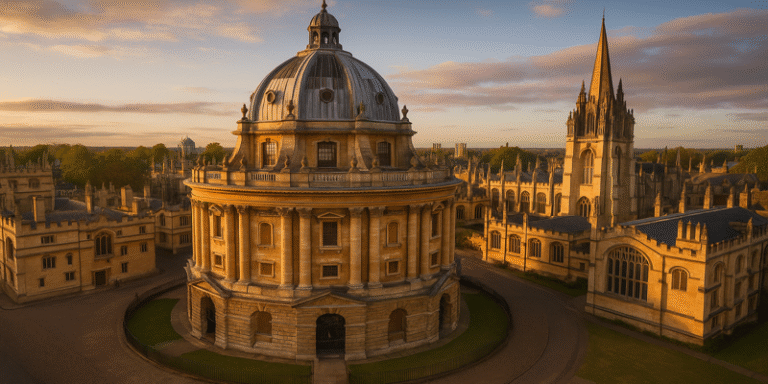The University of Oxford is one of the world’s most prestigious centres of learning, blending over nine centuries of academic tradition with cutting-edge research and global influence. Established in the late 11th or early 12th century, Oxford has educated generations of leaders, scientists, writers, and thinkers. While deeply rooted in tradition, the university remains at the forefront of modern innovation, playing a pivotal role in areas such as medical research, artificial intelligence, and vaccine development.
Origins and Historical Development
The exact founding date of the University of Oxford is uncertain, but teaching existed in Oxford as early as 1096 (Brockliss, 2016). The institution grew rapidly after 1167 when King Henry II forbade English students from attending the University of Paris (Leedham-Green, 1996). The early university was a loose association of scholars who taught and lived in rented halls before the establishment of formal colleges in the 13th century, starting with University College in 1249, Balliol College in 1263, and Merton College in 1264 (Catto, 1984).
Oxford became a major centre for scholasticism in medieval Europe, attracting students from across the continent. By the 14th century, it was a hub for theological and philosophical debates, contributing significantly to the intellectual and religious transformations of the time.
The Collegiate System
A distinctive feature of Oxford is its collegiate system, comprising 39 autonomous colleges and six permanent private halls (University of Oxford, 2023). Each college is an independent institution within the university, responsible for the admission, accommodation, and tutorial teaching of its students. This system fosters close-knit academic communities, offering personalised teaching through the tutorial system — one of Oxford’s most distinctive educational features (Tapper & Palfreyman, 2009).
The collegiate system also plays a vital role in student welfare, social life, and extracurricular activities. Colleges compete in sports, drama, and academic competitions, creating a vibrant and diverse student culture.
Teaching and Academic Traditions
Oxford’s teaching approach is renowned for its emphasis on critical thinking and independent study. The tutorial system pairs students with tutors, typically experts in their field, for intensive, small-group discussions (Palfreyman, 2008). This method encourages rigorous analysis, intellectual curiosity, and personalised feedback.
The university offers a broad range of disciplines, from humanities and social sciences to physical sciences and medicine. It is consistently ranked among the top universities globally for teaching quality, research excellence, and employability of graduates (Times Higher Education, 2023).
Research Excellence and Global Contributions
Oxford is a world-leading research institution, with notable contributions across multiple disciplines. In science and medicine, Oxford researchers have made ground-breaking discoveries — from Robert Hooke’s contributions to microscopy in the 17th century to the recent development of the Oxford-AstraZeneca COVID-19 vaccine in 2020 (Voysey et al., 2021).
The Oxford-AstraZeneca vaccine, developed in partnership with AstraZeneca and the Jenner Institute, was a crucial tool in the global fight against COVID-19, particularly in low- and middle-income countries due to its affordability and ease of storage (Knoll & Wonodi, 2021). Beyond medicine, Oxford researchers have influenced public policy, climate change mitigation, artificial intelligence ethics, and global health governance.
Oxford’s libraries, particularly the Bodleian Library, hold over 13 million printed items and vast digital collections, supporting research in the humanities, sciences, and beyond (Bodleian Libraries, 2023).
Notable Alumni and Influence
Oxford’s alumni network includes some of the most influential figures in history. In politics, it has produced 28 British Prime Ministers, including Margaret Thatcher, Tony Blair, and Rishi Sunak (University of Oxford, 2023). In literature, authors such as J.R.R. Tolkien, C.S. Lewis, and Philip Pullman studied or taught at Oxford, while in science, figures like Stephen Hawking and Dorothy Hodgkin made transformative contributions.
The university has also shaped global leadership, counting among its alumni leaders from countries including Australia, Canada, Pakistan, and the United States. Its impact extends to the arts, business, and international diplomacy.
Cultural Heritage and Student Life
Oxford is steeped in tradition, with ceremonies such as matriculation, formal hall dinners, and May Morning celebrations fostering a sense of continuity with the past. Academic dress, worn at formal occasions and examinations, reflects the university’s medieval origins.
Student life is enriched by over 400 clubs and societies, including the Oxford Union debating society, which has hosted figures from Winston Churchill to Malala Yousafzai (Oxford Union, 2023). The city’s museums, including the Ashmolean — the world’s first university museum — offer unparalleled cultural experiences (MacGregor, 2012).
Challenges and the Future
Like other leading universities, Oxford faces challenges in maintaining accessibility and diversity. Efforts to widen participation have included outreach programmes and contextual admissions policies aimed at increasing representation from under-represented groups (Boliver, 2015).
Looking ahead, Oxford is investing in sustainability, digital learning, and interdisciplinary research. Its new facilities, such as the Oxford Foundry for entrepreneurship and the Big Data Institute, show its commitment to addressing global challenges.
The University of Oxford is far more than a historic institution; it is a living, evolving centre of learning and innovation. From medieval scholasticism to 21st-century vaccine development, Oxford continues to shape the intellectual, cultural, and scientific landscape of the world. Its blend of tradition and innovation ensures that it remains at the forefront of global higher education.
References
Bodleian Libraries (2023) About the Bodleian Libraries. Available at: https://www.bodleian.ox.ac.uk/ (Accessed: 5 August 2025).
Boliver, V. (2015) ‘Are there distinctive clusters of higher and lower status universities in the UK?’, Oxford Review of Education, 41(5), pp. 608–627. https://doi.org/10.1080/03054985.2015.1082905
Brockliss, L.W.B. (2016) The University of Oxford: A History. Oxford: Oxford University Press.
Catto, J.I. (ed.) (1984) The History of the University of Oxford, Vol. 1: The Early Oxford Schools. Oxford: Clarendon Press.
Knoll, M.D. and Wonodi, C. (2021) ‘Oxford–AstraZeneca COVID-19 vaccine efficacy’, The Lancet, 397(10269), pp. 72–74. https://doi.org/10.1016/S0140-6736(20)32623-4
Leedham-Green, E.S. (1996) A Concise History of the University of Cambridge and the University of Oxford. Cambridge: Cambridge University Press.
MacGregor, A. (2012) The Ashmolean Museum: A Brief History of the Museum and its Collections. Oxford: Ashmolean Museum.
Palfreyman, D. (2008) ‘The Oxford Tutorial: Sacred Cow or Pedagogical Gem?’, Oxford Magazine, 271, pp. 12–15.
Tapper, T. and Palfreyman, D. (2009) Oxford, Cambridge, and the Changing Idea of the University: The Challenge to Donnish Dominion. London: Jessica Kingsley.
Times Higher Education (2023) World University Rankings 2023. Available at: https://www.timeshighereducation.com/ (Accessed: 5 August 2025).
University of Oxford (2023) About the University. Available at: https://www.ox.ac.uk/ (Accessed: 5 August 2025).
Voysey, M. et al. (2021) ‘Safety and efficacy of the ChAdOx1 nCoV-19 vaccine (AZD1222) against SARS-CoV-2’, The Lancet, 397(10269), pp. 99–111. https://doi.org/10.1016/S0140-6736(20)32661-1.









